My husband and I knew – 2016 was going to be the year we embarked upon another adoption journey.
We’d given birth to our first child, a daughter, in 2010. In February 2013 we adopted a precious little girl from China, and we knew then that we’d adopt again. First, though, we felt like God was leading us to pursue having another baby biologically. Our son joined us in November 2014.
We knew we needed to take 2015 to settle into life as a family of five, but we also knew that we wanted to start the adoption process again soon thereafter. As 2015 drew to a close, we began to talk about getting started on our home study but figured there was no real rush – we could continue to save money but get started any time, allow our agency to match us, and take things at a leisurely pace.
That all changed in January 2016.
I came across an advocacy post here at No Hands But Ours and saw the beautiful, bright eyes of a precious little girl. I showed the post to my husband, and we were both feeling very drawn to her, but…. to be honest, we were also a bit intimidated.
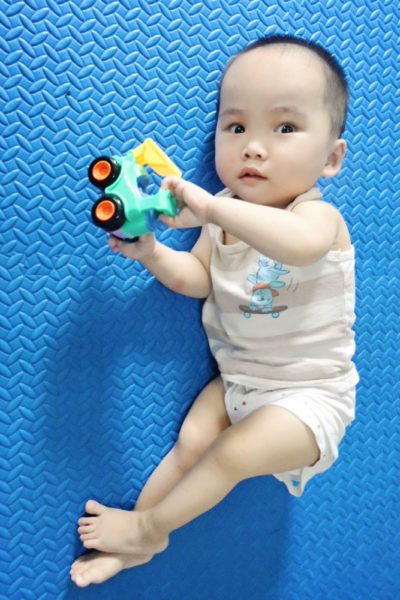
Our first adopted daughter’s special need essentially resolved itself within the first year she was home. But this little girl’s special need, osteogenesis imperfecta (OI), would be with her through her entire life. OI is also sometimes known as “brittle bone disease,” and though it can have other effects, the primary way in which it makes itself known is in the ease of bone fractures.
People with OI can break bones by falling down, like anyone else, but also just by living, doing nothing out of the ordinary at all. And because of the fragility of their bones – and particularly for children coming from orphanages where they have not received much medical treatment – kids with OI often have significant gross motor skill delays.
There would be measures we could take to mitigate the effects of OI – and there are more options and resources for doing so in the United States than there are in China – but it would be with her and would affect her life forever.
We knew that if we were to proceed with adopting her, she’d be our fourth child, and not only that, but one of four children ages six and under at the time she came home.
Would that dynamic, plus the severity of her special need, be too much for us?
Would it be unfair to her or unfair to the three children we already had at home?
What would life with OI really look like for her anyway – both her day-to-day life and the medical care she’d need?
We had a lot of questions.
Through Facebook I was able to connect with a number of mamas who had OI themselves or who had adopted children with OI, and they were immensely helpful.
I learned that OI affects each person differently. Some of that is dependent upon a person’s genetic type of OI, but some of it is essentially random. I learned that the little girl we were considering adopting most likely had a moderate form of OI.
These other mamas talked with me about medical care – and the importance of making sure your child is seeing doctors who have that experience and are up-to-date on the latest treatment protocols. Because OI is such a rare condition (it’s estimated that between 25,000 and 50,000 people in the United States have OI), most doctors do not have a great deal of experience working with people with OI.
And I learned about the ways we’d be able to care for fractures at home, about the mobility devices we’d probably need, and what sort of therapies we’d most likely want to pursue. I also learned about the amazing resilience and persistence kids with OI manifest and what a blessing their family members consider these precious kiddos to be.
Ultimately, after praying and seeking counsel from others – medical professionals, mamas living out the realities of life parenting little ones with OI, and some trusted friends, my husband and I decided to take the leap of faith to pursue adopting this little girl. We believed we could be a good family for her, and we were excited about the prospect of her joining our family as another beloved daughter.
The process itself wasn’t without hiccups – the most major of which was my husband suffering a heart attack the day after we received pre-approval. But with the support of our social worker, our agency, and our awesome friends and families, we continued on.
And in December 2016, this precious – and terrified – three-year-old girl was placed in my arms in Nanning, China.
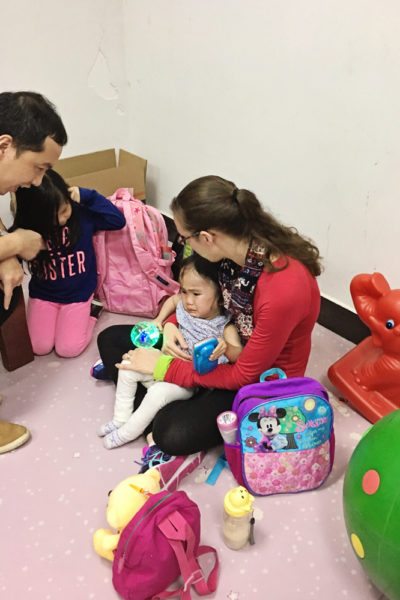
Once in China, I counted down the days – partly because my new daughter was grieving and was uninterested in bonding with me – but also because I was desperately hoping that at the very least we could make it back to the States without experiencing a major fracture.
I traveled with what OI parents call a “break box” – a collection of supplies (most of which were sent to me by another OI mom who also provided specific instructions about how to use each item) designed to allow me to splint almost any fracture on my own, without having to go to a hospital.
A nearby mom had come over one morning and given me a crash course on splinting, so between that and my packing cube stuffed full of break box supplies and pain meds, I felt as prepared as I possibly could be. But I was also very thankful that we made it through our time in China without any fractures.
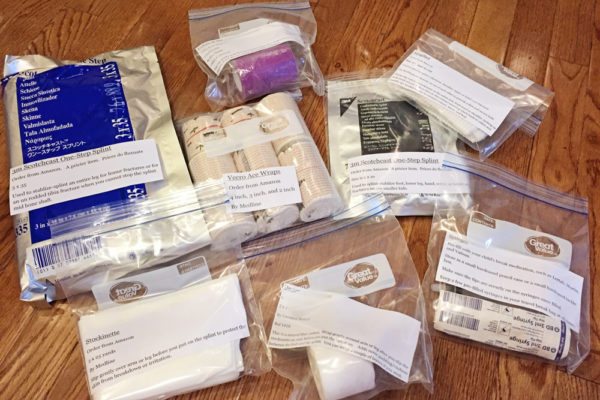
The first couple months home felt pretty intense.
We had FangFang evaluated by a private PT and OT, by the school system, and by a local organization that provides support to families of children with qualifying disabilities. Given that she came home at three years old scooting herself around on her bottom quite proficiently but not crawling, standing, or walking, she qualified for basically all services for which we had her evaluated.
She also had a CT scan and an optometrist appointment for unrelated issues that presented themselves, but our primary focus was and has continued to be on addressing the effects of her OI.
We established care with local doctors and with internationally known experts.
Months before, when we received our LOA and had a pretty good idea of what our travel dates would be, we made an appointment with the Omaha OI clinic. So, only a month after we returned home from China, we were able to travel there for an evaluation.
The orthopedic surgeon practicing at Omaha Children’s Hospital is one of the foremost experts on OI in the world, and there is an entire team of professionals there who have a great deal of experience working with children with OI and are dedicated to providing them with excellent care.
On our first day in Omaha, we had a dexa scan (to measure bone density) and a number of x-rays (to evaluate the status of FangFang’s bones and get a baseline), as well as an audiology exam to measure hearing (which can be affected by OI because of the three small bones in the ear that are essential to hearing.)
The next day, we met with an endocrinologist, who prescribed bisphosphonate infusions meant to increase bone density. The dexa scan we’d done showed that FangFang’s bone density was five standard deviations below the mean for children of her age, which obviously increases the probability of fractures, so the more we can do to increase that and build it up closer to a “normal” range, the better.
We were able to do the first of those infusions in Omaha that afternoon but, for subsequent infusions (given once every three months), the Omaha team coordinates with our local doctors so we can do them at our local children’s hospital.
We next met with the orthopedic surgeon, who recommended that we come back for femur rodding surgery sometime within the next three to six months, essentially as soon as she started trying to pull up to a stand. FangFang’s left femur had actually been rodded when it fractured in China, after she’d been moved to a foster home specializing in caring for children with OI, where she was able to get better medical care. However, her right femur had fractured and healed without being properly set so many times in China that it was incredibly bowed and would be highly likely to snap if she put much weight at all on it.
The clinic time in Omaha also gave us the opportunity to meet with a social worker, a dentist, multiple nurses, a physical therapist, and an occupational therapist, all in one morning. We were so grateful for the opportunity to meet with so many professionals who could lend their expertise to our daughter’s care all at once. The clinic experience was wonderful and so helpful to us in making plans for her care going forward.
We plan to return to Omaha annually for that clinic experience. It has obvious medical benefits and offers the additional advantage that we’re able to connect with other families of kids with OI and even some whose kiddos have been adopted from China, offering a built-in community for our kids (and for us) as they grow older.
We also went to Omaha this spring for FangFang’s femur rodding surgery. You can see from these photos the wonders her surgeon was able to accomplish for her. On the left is her femur pre-surgery with major, dangerous bowing. On the right is her femur post-surgery with a rod surgically implanted – so much straighter and stronger.
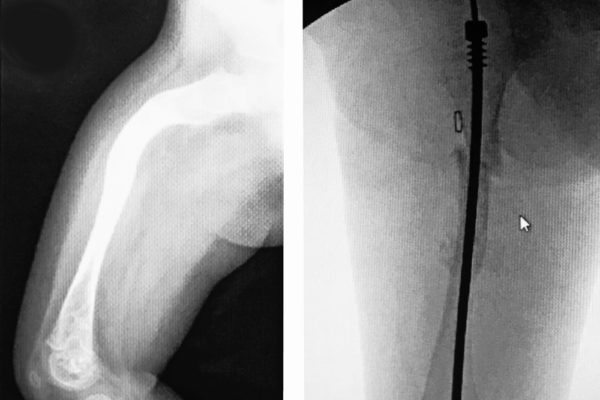
Femur rodding surgery is pretty standard for children with OI; not everyone has it, but most kids who have moderate to severe OI do. It has such benefits for straightening and strengthening bone that it is almost always advantageous to pursue. Sometimes rods are needed in other bones – notably the tibia or humerus – but it just depends on the individual person and their fracture patterns. Right now the only surgery we knew FangFang would need was the femur rodding surgery, but we know that at some point she may need to have other bones rodded, as well.
Beyond that, we’ve settled into daily life.
It looks a little bit different than life without OI, but honestly, the similarities are greater than the differences. There are things we do differently with FangFang than with our other kids. Notably, we travel everywhere with a break box just in case it’s needed. So far we haven’t had any major fractures, but we’ve had what we believe to be some minor fractures.
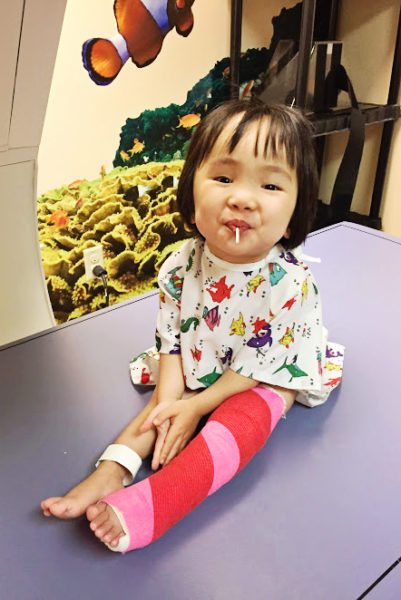
We don’t x-ray everything, because minor fractures don’t always show up, and for kids with OI, if it seems like a fracture, you treat it like a fracture, whether an x-ray verifies that or not, so if an x-ray isn’t going to change the course of treatment, we don’t necessarily want to expose her to the radiation. If it’s necessary, we can go in to our local orthopedic surgeon’s office, but if not, we just splint at home, offer some pain meds as needed, and move on with our days.
We follow her lead about the length of time she needs to remain splinted – per her orthopedic surgeon it was four weeks after her femur rodding surgery, but for these more minor fractures or potential fractures, it’s been anything from two to ten days.
At times, FangFang’s siblings, showing solidarity with her, have designed fashioned splints for themselves (and their stuffed animals) out of art supplies!
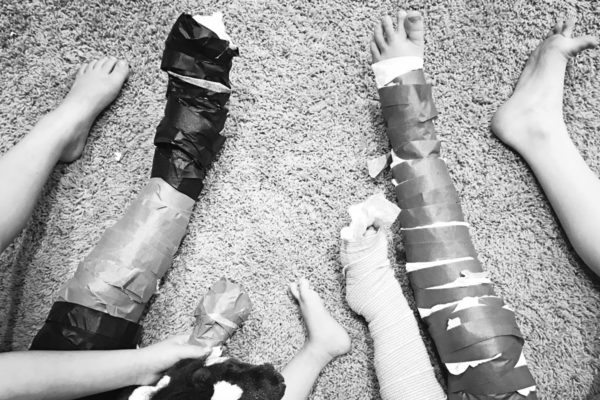
We’ve ordered a wheelchair for her, and we’re working through the process of getting insurance authorization to have the order actually filled. We hope to have the wheelchair by the end of the summer – it’s not a fast process. Getting evaluations and negotiating with insurance companies has been one of the more stressful parts of having a child with a complex medical need, but we’ve worked our way through it all, step by step, and we’ve gotten some great advice from mamas who have been there and done that.
Another part of our current routine is that FangFang does weekly private physical therapy (PT). We’ve recently switched to doing an aqua therapy, which is awesome for kids with OI, as it allows them to build strength and work on developing skills without having to bear all their weight all the time.
We’ve seen amazing growth since we started PT.
First she started army crawling, then crawling, and now that her femur has been rodded, she’s able to stand holding onto furniture. Witnessing the delight evident on her face each time she conquers a new milestone is amazing. She’ll turn to me, a triumphant look on her face, and exclaim, “Mama! I so strong!”
And she is.
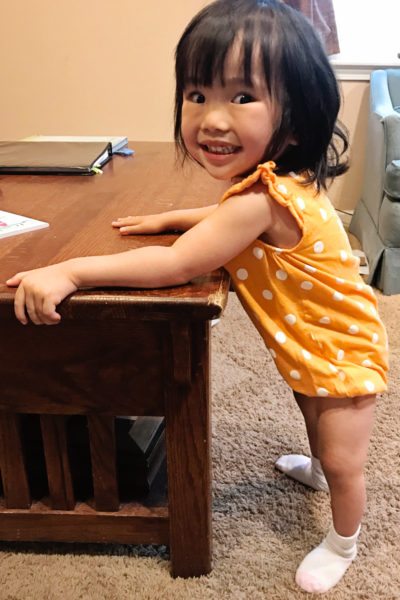
We’re blessed to be her family.
Yep, there are challenges…
We fight insurance companies and call specialists and get second opinions from doctors and mamas. We try to get creative to figure out how she can participate safely in her Sunday School class and on local playgrounds. We work to keep her safe but also allow her to be a kid and have fun.
But that has all become just part of normal life. We also read books and watch Peppa Pig. We do puzzles and go for walks. We laugh and play, and we enjoy life as a family together.
We’re so glad FangFang is a part of all of that.
– guest post by Allison: email || blog || instagram || facebook

























I know that no parent who adopts a special needs child –
and especially who writes about it here on NHBO – does so to hear anyone say, “My God, you’re amazing!” I do suspect, however, that if the reaction was, “Wow, GOD is amazing!”, that’d be fine. The fact of the matter is that it’s both of you who are amazing.
I think I am hooked on these stories because they show the relationship between God and His children as much as any adopted child featured in these pages.
Thank you for writing this and for bringing home Fang Fang. I saw her photo when it was listed and remembered her. So strong, indeed. All blessings to you and your family.
B. A. Butler